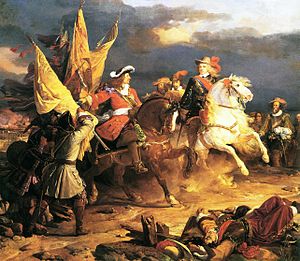Battle of Villaviciosa
| Battle of Villaviciosa | |||||||
|---|---|---|---|---|---|---|---|
| Part of the War of the Spanish Succession | |||||||
 Vendôme (left) presents the standards to Philip V of Spain (right) at Villaviciosa by Jean Alaux. |
|||||||
|
|||||||
| Belligerents | |||||||
|
|
|
||||||
| Commanders and leaders | |||||||
|
|
|
||||||
| Strength | |||||||
| 20,000 | 14,000 | ||||||
| Casualties and losses | |||||||
| 2,000–3,000 dead or wounded | 2,000–3,000 dead or wounded | ||||||
The Battle of Villaviciosa was a battle between a Franco-Spanish, on 10 December 1710, army led by Louis Joseph, Duke of Vendôme and Philip V of Spain and a Habsburg-allied army commanded by Austrian Guido Starhemberg. The battle took place during the War of the Spanish Succession, one day after a Franco-Spanish victory at Brihuega against the British army under James Stanhope. Both Philip V of Spain and the Archduke Charles of Austria claimed victory, but the number of dead and wounded, the number of artillery and other weapons abandoned by the Allied army and the battle's strategic consequences for the war confirmed victory for Philip.
The battle was largely determined by the Spanish dragoons commanded by the Marquis of Valdecañas and the Count of Aguilar, which far exceeded the opposing forces. The Austrian forces retreated, pursued by Spanish cavalry, and the allied army was reduced to 6,000 or 7,000 men when it reached Barcelona (one of the few places in Spain still recognizing Charles' authority) on 6 January.
After victories in the 27 July Battle of Almenara and the 20 August Battle of Saragossa, the Habsburg allies supporting Archduke Charles captured Madrid for the second time and Charles entered Madrid on 21 September. The 1710 invasion was a repetition of the one in 1706, and the 23,000-strong allied army was reduced at Almenara and Saragossa and in skirmishes with the Spanish-Bourbon militia. The allied troops were unable to maintain an occupation.
The allied position in Madrid was dangerous. On 9 November the city was evacuated and the retreat to Catalonia began, pursued by Spanish cavalry led by the Marquis of Valdecañas. The archduke left the army with 2,000 cavalry and rushed back to Barcelona, while the rest of the army marched in two detachments. Austrian general Guido Starhemberg and the main body of 12,000 men were a day's march ahead of the 5,000 British troops under Lord Stanhope. The British force, surprised, was defeated at Brihuega on 9 December 1710. The British were taken prisoner (including Stanhope, who finally surrendered).
...
Wikipedia
